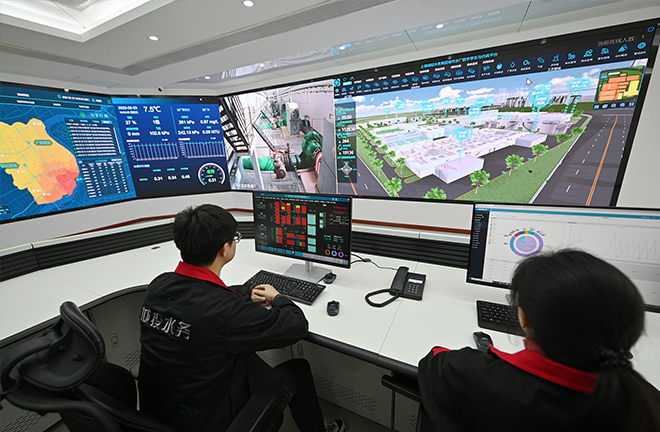Blockchain supports carbon goals

A digital twin system employed in a sustainable water management system in Shanghai, Feb. 23 Photo: CFP
Digital transformation is the basis and guarantee for high-quality ecological development. Against the backdrop of realizing carbon goals, digital technologies have been a powerful driver for China to prevent and control pollution, improve resource utilization efficiency, enhance ecosystems’ quality, and promote economic development. Digitalization and ecologicalization are closely related, while blockchain further promotes the synergistic development of digitalization and ecologicalization.
Development prospects
Blockchain, as an emerging digital technology, has an important impact on reshaping the industrial ecosystem and even social organizations’ mode of operation. As a chained data structure, blockchain is capable of data storage, transmission, encryption, and more through its application process, and it is almost impossible to tamper with or forge.
In terms of digital transformation, blockchain has been integrated with the intelligent manufacturing industry and employed widely.
To support high-quality ecological development, blockchain has played an important role in carbon monitoring, emission reduction, deduction, and trading. Carbon emissions’ trading is currently considered a good means to effectively control CO2 emissions and achieve optimal resource allocation.
Blockchain can collect carbon emission data from individual enterprises through Internet of Things (IoT) devices and manage carbon emission data on the chain. The carbon-trading path can be effectively tracked through blockchain to ensure the trading process is transparent and credible. In addition, private computing can ensure that the data is shared with regulators and other participants—within the scope of permission—which is convenient for all relevant parties to check and inspect, greatly enhancing the transparency and credibility of the trading process.
Potential risks
Blockchain should serve social progress, but this process also comes with risks and challenges. First, at the technical level, as quantum computing develops, there is a possibility that the current effective encryption algorithm will be cracked. Second, at the data level, as blockchain data is difficult to substitute, delete, or tamper with, it may lead to malicious information being added to the chain and then spread and abused. Third, on application levels, blockchain abuse may well occur. Fourth, at the operating entity level, decentralization dilutes the state’s ability to regulate.
The above-mentioned issues require the state and regulators to seek a balance between centralization and decentralization. Respecting and realizing the unity of scientific and humanistic spirit is an important task in blockchain’s development process.
Path choices
At present, several countries are accelerating blockchain deployment, and its applications have been extended to include the IoT, intelligent manufacturing, supply chain management, digital finance, digital asset trading, and other fields. In this regard, we should actively promote the innovation and development of blockchain and related industries and accelerate blockchain’s application as we integrate digitalization and ecologicalization.
First, we should accurately employ “blockchain plus” to promote high-quality ecological development. For one, we should use blockchain to activate the vitality of the carbon trading market. Initially, we should use blockchain to share records from the multi-node network in the carbon market. Furthermore, the decentralized, open, and transparent nature of blockchain data enables the traceability of carbon emissions. Finally, blockchain can make each enterprise’s emissions share the characteristics of an asset, regardless of the size of the enterprise. For another, we should also use “blockchain + IoT” for industrial environmental monitoring. Using IoT technology, enterprises can collect and monitor pollution emission terminal equipment, systems, and other sources to capture data in real time. In addition, enterprises can carry out “zero carbon talent” certification, forming an internal certified emission reduction certification system. In the future, this may be linked with financial institutions to establish “carbon accounts” to offer financial service scenarios and enhance the awareness of green consumption for all.
Second, blockchain should be properly used to promote digital transformation. We should use blockchain for internal management and external collaboration. By using blockchain to eliminate information asymmetry, we can explore new mechanisms of industrial operation. Using “blockchain + digital twins” we can enhance carbon emission awareness. Achieving carbon neutrality requires the whole industrial chain to be carbon neutral. Enterprises need to understand the carbon emission ratio of each chain, technology, and build a carbon asset map for enterprises via “blockchain + digital twins,” to enhance the visualization of carbon emissions, distributions, and flow, and to uncover high carbon emission links to formulate targeted emission reduction strategies.
Third, we should strengthen top-level design of blockchain application and regulation. This can be accomplished by establishing a flexible regulatory mechanism, building a regulatory system in high-risk industries, important fields, and application scenarios, coordinating the regulatory work of standard-setting entities, industrial organizations, and national agencies, and establishing a top-down unified and graded regulatory entity. Next, we should strengthen legal system construction, enhance financial governance, and prevent currency risks. By accelerating blockchain research and development, we can strengthen blockchain applications in social governance, build a credible society, promote the economy and society’s digital transformation, create blockchain for ecological development, and improve regulatory awareness and supervision. Then, based on the national economic credit and social credit system, in combination with the national digital infrastructure system, we should establish matching services in public welfare supply and demand. We should also strengthen the development of a blockchain service network (BSN).
Fourth, we should actively promote the construction of a collaborative communication and governance mechanism among the government, enterprises, and the public. This can only be accomplished by actively promoting collaboration between the government and enterprises. Using large enterprises’ technical advantages, government departments can integrate resources to promote the reasonable flow of business, information, and resources in social management, social services, social security, and social supervision. As a next step, deeper interaction between the government and the public should be promoted. Finally, the public interests of government, enterprises, the public, and other entities should be balanced to form a closely related symbiotic relationship.
Li Qun is vice chairman of the China Eco Development Association. Yang Wang is vice president of The Hong Kong University of Science and Technology.
Edited by ZHAO YUAN
